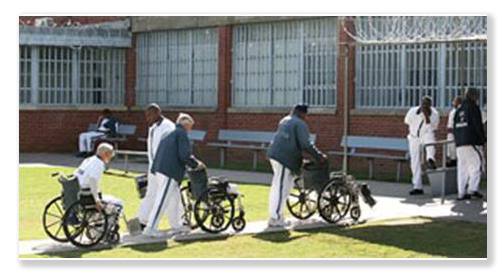We post news and comment on federal criminal justice issues, focused primarily on trial and post-conviction matters, legislative initiatives, and sentencing issues.

ROGER, DODGER, INMATE CODGER – THE ABCS OF THE EOHD
There seems to be a lot of confusion about the Elderly Offender Home Detention program approved by the First Step Act, judging from the questions still piling up in our email.
 • Where did EOHD come from? Back in 2009, the Second Chance Act of 2007 authorized the BOP to run a two-year pilot program to permit non-violent elderly offenders (65 years and older) to go to home confinement for the remainder of their sentences if they had been down 10 years and done 75% of their sentences. The program was tested at only one facility (FCI Elkton) for a two-year period.
• Where did EOHD come from? Back in 2009, the Second Chance Act of 2007 authorized the BOP to run a two-year pilot program to permit non-violent elderly offenders (65 years and older) to go to home confinement for the remainder of their sentences if they had been down 10 years and done 75% of their sentences. The program was tested at only one facility (FCI Elkton) for a two-year period.
It did not work that well, because the combination 10-year minimum and 75% seemed to eliminate just about everyone who otherwise would otherwise had been eligible.
• What is it now? The First Step Act has now re-established the program, calling it the Elderly Offender Home Detention program. The new EOHD would apply ay every BOP facility – not just one – and be extended to all nonviolent elderly offenders who had completed 66.67% (no longer 75%) of their sentences. The 10-year minimum service of sentence was eliminated.
Under the program, an eligible inmate could go to home confinement at 66.67% of the whole sentence, and be released from home confinement to supervised release at 85% of his or her sentence.
 • What are the requirements? Most of the requirements have not changed from the pilot program. Anyone seriously thinking about applying for EOHD should read 34 USC 60541(g). Among other requirements, the eligible offender has to be 60 years old or older, cannot ever have been convicted of a crime of violence or sex offense, have served 66.67% of “the term of imprisonment to which the offender was sentenced,” have never tried to escape, whose home detention will save the BOP money, and who the BOP determines “to be at no substantial risk of engaging in criminal conduct or of endangering any person or the public if released to home detention.”
• What are the requirements? Most of the requirements have not changed from the pilot program. Anyone seriously thinking about applying for EOHD should read 34 USC 60541(g). Among other requirements, the eligible offender has to be 60 years old or older, cannot ever have been convicted of a crime of violence or sex offense, have served 66.67% of “the term of imprisonment to which the offender was sentenced,” have never tried to escape, whose home detention will save the BOP money, and who the BOP determines “to be at no substantial risk of engaging in criminal conduct or of endangering any person or the public if released to home detention.”
• It is 66.67% of what? Our reading of the statute suggests that the two-thirds must be of the whole sentence, not the sentence minus good-time, or minus earned time credits, or even minus RDAP. In fact, RDAP would have to be restructured to let eligible elderly offenders take it early in order to get any meaningful EOHD time.
• Can the BOP adopt other rules on how to run EOHD? We suspect that the BOP will treat it like it treats direct-to-home detention now. The inmate has to have a home that passes US Probation Office inspection, have the landline phone rig needed for monitoring, and have health insurance. The BOP has a lot of leeway in administering the program, and not everyone who is eligible will necessarily be permitted to go home.
When the BOP ran the program at Elkton, there was no program statement, because the program was pretty ad hoc and loosey-goosey. The BOP will probably issue a program statement now, detailing how it intends to administer the program.
One final caveat: the EOHD will not necessarily be available at all institutions. The Attorney General retains the authority to designate only certain institutions at which the EOHD will operate. However, if only somer and not others are designated, it will usher in a land-rush of inmates seeking to get to certain prisons and not others in order to benefit from the Act. If too few institutions are designated, Congress may be irate that the BOP is not using a tool available to it to reduce its costs, especially the horrific cost of elderly medical and nursing care.
 I have already heard of one institution where a case manager confidently told an inmate that the warden would never approve any EOHD participants. The BOP will have a lot of discretion as to how it runs EOHD, but it will not have the discretion to NOT run it.
I have already heard of one institution where a case manager confidently told an inmate that the warden would never approve any EOHD participants. The BOP will have a lot of discretion as to how it runs EOHD, but it will not have the discretion to NOT run it.
One benefit inmates have with EOHD may be judicial review. Under 18 USC 3625, virtually all of the BOP’s programs – halfway house, the anti-recidivism programming and placement, for example – are immune from the usual Administrative Procedure Act lawsuits an inmate could otherwise bring under 5 USC 706. However, the EOHD is authorized by a different section – in Title 34 – and appears to be subject to APA challenge if the BOP gets too arbitrary or deviates too far from the statute. That ought to give inmates a bit more leverage than they have with other BOP actions.
Elderly Offender Home Detention, 34 USC 60541(g) (as amended by the First Step Act)
– Thomas L. Root

